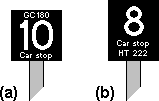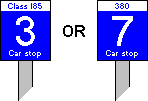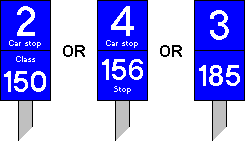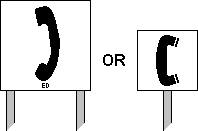Section 21: Stopping Markers
(Page 6 of 9)
The standard form of car stop marker may have letters or numbers added at the top or bottom to indicate which type of train it applies to [21.109], which train operating company's services it applies to [21.110], or a combination of both [21.111].
 |
 |
 |
[21.109] Train Class Specific Car Stop Markers ( (a) - e.g. Class 222 trains; (b) - e.g. "HST" for High Speed Trains ).
Area: Various
Usage: Medium
Status: Current
|
[21.110] Train Operator Specific Car Stop Markers ( (a) - e.g. "ATW" for Arriva Trains Wales; (b) - e.g. "CRCL" for Chiltern Railways Co. Ltd. ).
Area: Various
Usage: Medium
Status: Current
|
[21.111] Train Operator and Class Specific Car Stop Markers ( (a) - e.g. "GC 180" for Grand Central Class 180 trains; (b) - e.g. "HT 222" for Hull Trains Class 222 trains ).
Area: Various
Usage: Medium
Status: Current
|
The applicable type of train or the train operating company may be specified on a contrasting white band at the top of a standard car stop marker [21.112 & 21.113]. The applicable type of train and the train operating company can be shown on separate white bands at the top and bottom of the same car stop marker [21.114].
 |
 |
 |
[21.112] Train Class Specific Car Stop Marker (e.g. applicable to Class 185 and 350 trains).
Area: All Areas
Usage: Medium
Status: Current
|
[21.113] Train Operator Specific Car Stop Marker (e.g. applicable to ScotRail trains).
Area: All Areas
Usage: Medium
Status: Current
|
[21.114] Train Operator and Class Specific Car Stop Marker (e.g. applicable to ScotRail High Speed Trains).
Area: All Areas
Usage: Medium
Status: Current
|
|
In May 2005, new stop markers were provided on Platform 4 at Brockenhurst station to facilitate occasional platform sharing. Two separate "S car stop" markers were installed, facing to Up direction trains. One with the legend "Plat 4A" was located at the north end of the platform, and one with the legend "Plat 4B" was located close to the middle of the platform [21.115].
|
 |
[21.115] Car Stop Marker.
Area: Brockenhurst
Usage: Low
Status: Current
|
|
|
A new service known as 'Heathrow Connect' began in June 2005. Special stop markers were provided for the Class 360 electric multiple units that operate these services [21.116].
|
 |
[21.116] Car Stop Marker.
Area: Heathrow Connect
Usage: Medium
Status: Obsolescent
|
|
|
When two 4-car Class 350 'Desiro' electric multiple units are working together in multiple, 'Unit Deselect' (UDS) can be used at platforms that are too short to accommodate all the train doors. When Unit Deselect is used, only the doors on the front unit can be opened. At stations where this applies, "UDS" boards are provided [21.117]. The driver should bring the train to a stand at the "UDS" board to ensure that the leading cab door of the rear unit is on the platform. The conductor will operate Unit Deselect from the leading cab of the rear unit.
|
 |
[21.117] Unit Deselect Board.
Area: Central Trains
Usage: Medium
Status: Current
|
|
|
Some stations on the Great Northern lines, operated by First Capital Connect, have blue car stop markers with the words "car stop" surrounded by a white rectangle [21.118].
|
 |
[21.118] Car Stop Marker.
Area: First Capital Connect
Usage: Medium
Status: Uncertain
|
|
|
New car stop markers were provided for the TransPennine Express Class 185 'Desiro' diesel multiple units, which entered service from March 2006. These markers have a blue background, and the class number appears at the top in blue against a contrasting white band [21.119]. Similar train class specific car stop markers have subsequently been used for other classes of units.
|
 |
[21.119] Train Class Specific Car Stop Marker.
Area: Various
Usage: High
Status: Current
|
|
The stop markers at some Northern Rail stations show the relevant number of cars on a blue background but omit the words "car stop" (see [21.1]). More than one figure is shown where the stopping positions for trains of different lengths coincide [21.120]. Some Northern Rail stop markers have a separate plate fitted below them to indicate that they apply to a specific class of unit [21.121].
 |
 |
[21.120] Stop Marker.
Area: Northern Rail
Usage: Medium
Status: Current
|
[21.121] Stop Marker with plate indicating applicable class of unit.
Area: Northern Rail
Usage: Medium
Status: Current
|
|
Some stop markers at stations managed by Arriva Trains Wales bear a number that denotes the applicable class of unit rather than the number of cars in the train [21.122]. Some have the word "stop" or a letter "S" below the number.
|
 |
[21.122] Train Class Specific Stop Marker.
Area: Arriva Trains Wales
Usage: Medium
Status: Current
|
|
|
In December 2006, supplementary stop markers were provided at Southampton Central station in connection with platform sharing [21.123]. These apply to 2, 3 or 4 car trains stopping in the 'B' (west) end of Platforms 2 or 3, and permit platform sharing with an 8-car EMU in the 'A' (east) end. The platform number is specified on the signs, which have a white background to distinguish them from the ordinary stop markers.
|
 |
[21.123] Supplementary Stop Marker.
Area: Southampton Central
Usage: Low
Status: Historical
|
|
|
In June 2007, an advance stopping point marker comprising a large board showing a silhouette of a telephone handset [21.124] was provided approximately 160 metres on the approach to signal CO632 at Trimley, which controlled the exit from the Felixstowe North Quay line. An additional signal post telephone was located alongside this board. For environmental reasons, drivers were normally required to stop the train at the advance stopping point marker when signal CO632 was displaying a 'danger' aspect. In July 2017, a similar marker was installed on the line from Felixstowe Town, 251 metres on approach to signal CO624, which stood adjacent to signal CO632. Both markers were removed in May 2019 when revised signalling arrangements were introduced.
|
 |
[21.124] Advance Stopping Point Marker.
Area: Trimley
Usage: Low
Status: Historical
|
|
|
Where provided, Selective Door Operation boards at London Midland stations have just the initials "SDO" in white on a black background [21.125].
|
 |
[21.125] Selective Door Operation Board.
Area: London Midland
Usage: Medium
Status: Current
|
|
Stop markers applicable to South West Trains Class 450 or Class 444 'Desiro' electric multiple units have been provided at some stations. These bear the class number above the words "car stop" [21.126 & 21.127]. Strictly speaking, the inclusion of the word "car" on these markers is inappropriate, since the number "450" or "444" refers to the class of train rather than the number of cars. There is also a combined style of marker, which applies to both classes of unit [21.128].
 |
 |
 |
[21.126] Class 450 Stop Marker.
Area: South West Trains
Usage: Medium
Status: Current
|
[21.127] Class 444 Stop Marker.
Area: South West Trains
Usage: Medium
Status: Current
|
[21.128] Class 44x/450 Stop Marker.

Area: South West Trains
Usage: Low
Status: Current
|
|
Northbound services operated by Class 450 units regularly couple together at Woking station to form a combined train to London. A special car stop marker at the London end of Platform 1, which includes the letters "AP" for "attach portion" [21.129], indicates where the first train should come to a stand, to allow the second train to attach without its front end stopping over the AWS magnet.
|
 |
[21.129] Car Stop Marker for Attaching Trains.
Area: Woking
Usage: Low
Status: Historical
|
|







